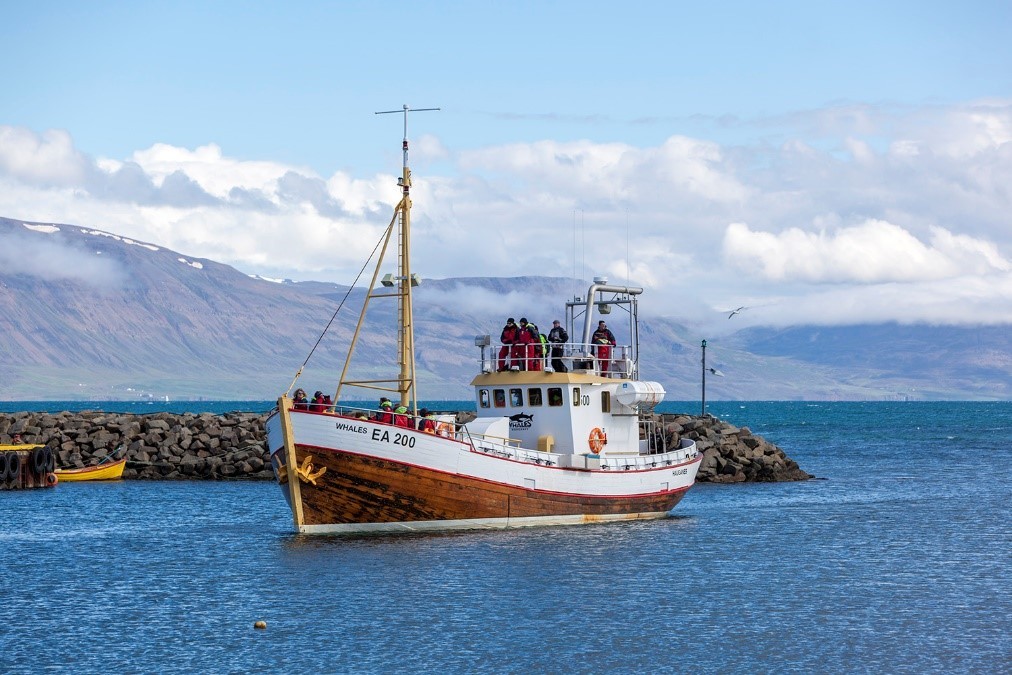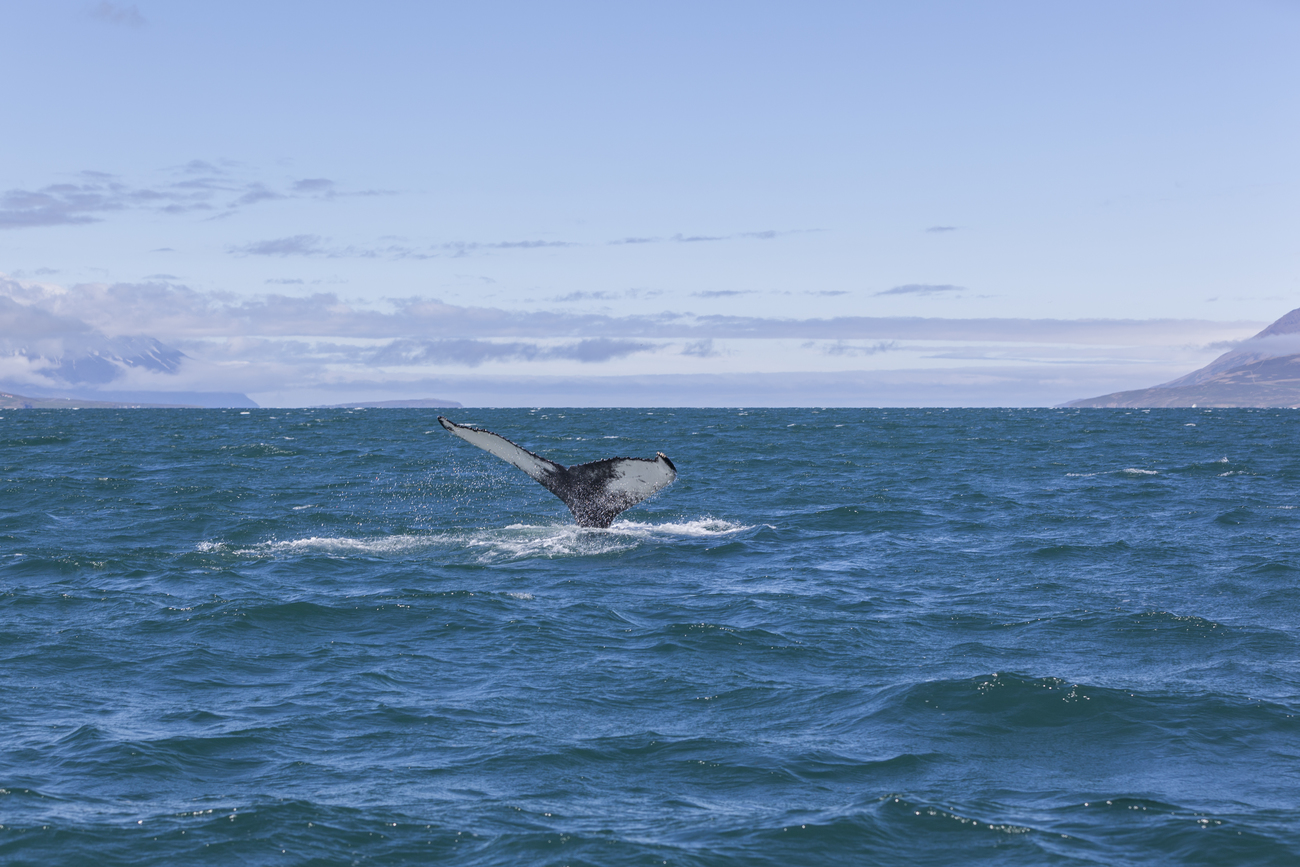Commercial Whaling Opposition - Global
We’re shifting the global mindset and protecting whales for the futureWhale Day in Iceland: my experience celebrating with Meet Us Don’t Eat Us campaigners
Whale Day in Iceland: my experience celebrating with Meet Us Don’t Eat Us campaigners

A chilly wind blows enormous white clouds, while the blazing sun contrasts beautifully against the black land surrounding Keflavik International, Iceland’s main airport on the morning of 20 June 2019.
We just landed in the country as part of IFAW’s delegation to celebrate Iceland’s second annual Whale Day and attend the inauguration of a new room inside the Whales of Iceland museum. As you have guessed, our Iceland work revolves around whale conservation!
This is my first time here and the hour-long ride from the airport to the capital Reykjavik already offers breath-taking landscapes that continue as far as the eye can see.
IFAW has been working in Iceland since 2003 when authorities announced they would restart commercial whaling. A big part of our work there is to raise awareness on the need to protect whales and their importance to the marine ecosystem. We also oppose all commercial whaling and promote responsible whale watching as a profitable and sustainable alternative that is better for whales and coastal communities. In support of our campaign, we collaborated with Whales of Iceland museum to create a new space dedicated to whale conservation and the solutions that can be implemented to save fin whales.
If like me, you have never had a close experience with a whale, entering the museum that exhibits life-size models of these magnificent animals makes quite an impression. Surrounded by a 25-metre blue whale, a humpback whale, and a sei whale, I feel so little and am immediately reminded that we must do whatever we can to protect these species.
The opening ceremony goes well with high-level guests in attendance, official speeches, and ribbon cutting. The voice of Icelandic singer and IFAW ambassador Ragnheiður Gröndal echoing in the main room under the blue lighting gives a last amazing touch to this beautiful and inspiring event.
I met Sigursteinn Masson, IFAW's representative in Iceland, back in November on my second day with IFAW and I remember being immediately impressed by his passion for the issue and his personal involvement in the campaign. Nevertheless, it is only tonight that I realize the extent of the work he has done over the past 16 years to protect whales from commercial whaling!
Hundreds of visitors are eager to visit the museum and learn about whale conservation, while just a few years ago, whaling was a nationalistic issues that could not be opposed publicly. This year is the first year since 2003 without any whaling in Iceland, proving a real change in people’s mind-set.
On that first night in Reykjavik after a dinner with our partners, researchers, and friends, we walk around the harbour under a cold midnight sun. Just one day before the summer solstice, the sun illuminates the sky and water with a red hallow before setting beyond the horizon for only a few hours.
Friday we begin the day with a quick debrief at Whales of Iceland. Martyna Daniel, the Operations Manager at the museum, is relieved. After months of non-stop work and stress, we all agree that the evening was a success. There is still room for improvement obviously, but time will solve the details. A few kids try to climb a humpback whale; Martyna runs and comes back to us. There is also a quick moment of panic when we realize the amazing ocean noise station, which details to visitors the impact of underwater noises on whales, is about to break after careless use by some people. Problem solved a few hours later, the station runs again – so does the noise in the world’s oceans.

We then spend the day with Marvin Dupree, IFAW’s campaigner who leads the “Meet Us Don’t Eat Us” campaign in Iceland. The objective is to raise awareness among tourists on the urgently needed protection of whales as well as the value of sustainable whale watching as a viable alternative to the negative impact of commercial whale hunt and touristic whale meat consumption.
The concept, which is now offered as an Airbnb Experience, is quite simple but very impactful: encourage tourists in Iceland to understand the harm of consuming minke whale meat, choose sustainable whale watching companies, and spread the message to other tourists. Marvin speaks of his work with bright eyes, sharing memories of tourists he has met —those who were shy and wanted to learn more for themselves, and other who really played the game and proactively campaigned.
We tour the old harbour and look at the two whaling boats of Hvalur hf, the only company involved in Icelandic fin whaling. Docked in front of several whale watching vessels, what a sweet irony! We take photos after photos, with the goal in mind of sharing our experience with others and engaging with the next volunteers.
In the evening, most of us fly north to Akureyri for tomorrow’s Whale Day celebrations. During the one-hour drive between Akureyri airport and our first stop, Husavik, I am amazed at the scenery: small rivers surrounded by wide green spaces that lay below high dark mountains with a dome of snow. I did not know much about Iceland before coming and did not expect to see that much greenery. The incredible view is enhanced by a warm sunlight that pierces through the rainy clouds even though it is past 11pm: on Summer solstice, the sun does not set at all in Husavik.
We spend the morning at the Húsavík Whale Museum with museum director Eva Björk Káradóttir, scientists, and whale experts. In honor of Whale Day, the museum is free and visitors slowly begin to arrive. The Húsavík Whale Museum is a very different atmosphere compared to the Whales of Iceland museum. While the latter had this enchanting atmosphere with the life-size models, the former presents real whale skeletons from an extensive variety of specimen, including the blue whale who stranded on an Icelandic beach in 2010. Through posters, infographics, photos and videos, the museum describes the history of whaling in Iceland and its impact on whales.
After meeting with Icelandic and international researchers, we drive back to Akureyri where another highlight of the trip awaits us: a whale watching tour. Due to the lack of time, we do not go on the traditional vessel but on speedboat instead. With full body suits, masks, and gloves to protect us from the cold, we are ready!
We ride within the magnificent Eyjafjörður fjord, under a beautiful sun, jumping off the waves of the dream blue waters. My mind goes off somewhere else as I try to take in as much of the landscape in my memory – downside of this kind of boat is you need to hold on most of the time, which means less photos to take.
Suddenly, a humpback whale swims right below the surface a dozen meters away from us. We slow down and carefully get closer . A second one appears and dives, offering us an iconic tail splashing. Soon there are about five whales swimming in a 50-meter circle around us. Our guide recognizes the whales by their unique markings and tail shapes, and tells us each of their names. An hour later, it is time to ride back to port; reality catches up with us…
We finally drive to the villages of Hauganes and Dalvik where we meet IFAW’s whale watching partners who also organized different activities for tourists in celebration of Whale Day. They are proud to show the new IFAW logo present in the office, but they primarily appreciate us coming up north, as they feared all eyes would be solely on Reykjavik. Investing time and energy in these crucial relationships in the field is a key component of IFAW’s work and often is what can make the difference between the success and the failure of a whole project. Giving a sense of ownership to those who do the daily work and will continue to do so for the decades to come is key. We fly back to Reykjavik, meet with the rest of the team to hear about the activities they supervised, and then pack our bags for the return home in the early morning.
Whales in Iceland are safe this year, thanks to everyone’s efforts, dedication, and support — but the future remains uncertain. Our work can’t stop. And neither can your support. We’ll continue to campaign for whale protections and promote sustainable alternatives to whaling and whale meat consumption. With the help of tourists and people like you, we can save Iceland’s whales and create a world where we thrive alongside marine mammals.
-Benjamin Wiacek, EU Communications Manager
Related content
Updates
whale entanglements in Australia: how you can help
read moreExpert opinions
we asked whale expert Sigursteinn Másson about the Iceland whaling industry—here's what he revealed
Read moreBlog
ifaw-led research confirms North Atlantic right whale mortalities driven overwhelmingly by man-made causes
Read moreOur work can’t get done without you. Please give what you can to help animals thrive.